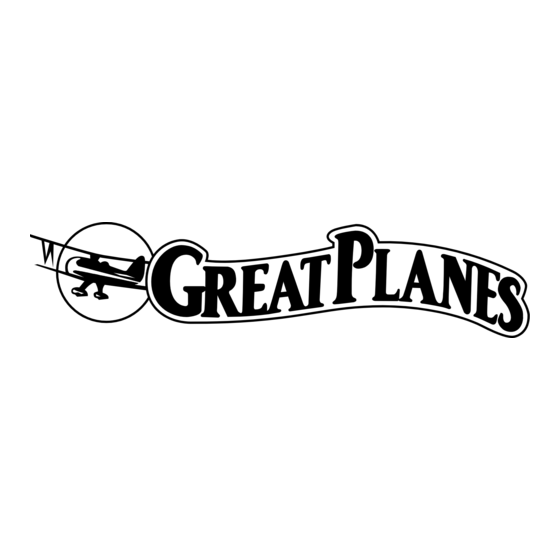GREAT PLANES S.E.5a Manuale di istruzioni - Pagina 18
Sfoglia online o scarica il pdf Manuale di istruzioni per Aerei GREAT PLANES S.E.5a. GREAT PLANES S.E.5a 20.

Proper Care of Your Motor
Using multiple battery packs to run the motor for successive
flights may cause the motor to become excessively hot. We
recommend at least a 10-minute motor cool-down period
between flights.
Ground Check
After you break-in the motor on the model, inspect the
model closely to make sure all screws remained tight, the
hinges are secure, the prop is secure and all pushrods and
connectors are secure.
Range Check
Ground check the operational range of your radio before the first
flight of the day. With the transmitter antenna collapsed and the
receiver and transmitter on, you should be able to walk at least
100 feet [30m] away from the model and still have control. Have
an assistant stand by your model and, while you work the
controls, tell you what the control surfaces are doing. Repeat this
test with the motor running at various speeds with an assistant
holding the model, using hand signals to show you what is
happening. If the control surfaces do not respond correctly, do
not fly! Find and correct the problem first. Look for loose servo
connections or broken wires, corroded wires on old servo
connectors, poor solder joints in your battery pack or a defective
cell, or a damaged receiver crystal from a previous crash.
MOTOR & BATTERY SAFETY
PRECAUTIONS
Failure to follow these safety precautions may result
in severe injury to yourself and others.
Use safety glasses when running the motor.
Do not run the motor in an area of loose gravel or sand; the
propeller may throw such material in your face or eyes.
Keep your face and body as well as all spectators away from
the plane of rotation of the propeller as you run the motor.
Keep these items away from the prop: loose clothing, shirt
sleeves, ties, scarfs, long hair or loose objects such as
pencils or screwdrivers that may fall out of shirt or jacket
pockets into the prop.
Always remove the LiPo battery from the plane before charging.
Always use a charger designed to charge LiPo batteries for
charging the LiPo flight battery.
Never leave the LiPo battery unattended while charging. If the
battery becomes more than just warm, discontinue charging.
AMA SAFETY CODE (excerpts)
Read and abide by the following excerpts from the Academy
of Model Aeronautics Safety Code. For the complete Safety
Code refer to Model Aviation magazine, the AMA web site or
the Code that came with your AMA license.
1) I will not fly my model aircraft in sanctioned events, air
shows, or model flying demonstrations until it has been
proven to be airworthy by having been previously,
successfully flight tested.
2) I will not fly my model aircraft higher than approximately
400 feet within 3 miles of an airport without notifying the
airport operator. I will give right-of-way and avoid flying in the
proximity of full-scale aircraft. Where necessary, an observer
shall be utilized to supervise flying to avoid having models
fly in the proximity of full-scale aircraft.
3) Where established, I will abide by the safety rules for the
flying site I use, and I will not willfully and deliberately fly my
models in a careless, reckless and/or dangerous manner.
5) I will not fly my model unless it is identified with my name
and address or AMA number, on or in the model. Note: This
does not apply to models while being flown indoors.
7) I will not operate models with pyrotechnics (any device
that explodes, burns, or propels a projectile of any kind).
Radio Control
1) I will have completed a successful radio equipment ground
check before the first flight of a new or repaired model.
2) I will not fly my model aircraft in the presence of
spectators until I become a qualified flier, unless assisted by
an experienced helper.
3) At all flying sites a straight or curved line(s) must be
established in front of which all flying takes place with the
other side for spectators. Only personnel involved with flying
the aircraft are allowed at or in the front of the flight line.
Intentional flying behind the flight line is prohibited.
4) I will operate my model using only radio control frequencies
currently allowed by the Federal Communications Commission.
5) I will not knowingly operate my model within three
miles of any pre-existing flying site except in
accordance with the frequency sharing agreement
listed [in the complete AMA Safety Code].
9) Under no circumstances may a pilot or other person touch
a powered model in flight; nor should any part of the
model other than the landing gear, intentionally touch
the ground, except while landing.
18
General
